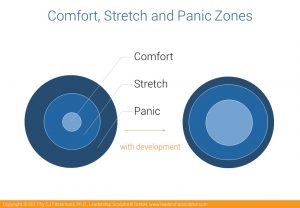Letting people stay in their comfort zone has a bad press; more people recommend setting stretch goals for your people so that they develop. These two ideas are actually complementary, as the simple chart Shows
 The inner or comfort zone represents the set of skills and tasks that a person has mastered; they’re comfortable doing them.
The inner or comfort zone represents the set of skills and tasks that a person has mastered; they’re comfortable doing them. - The outer or panic zone contains the teypes of tasks and skills that freak that same person out.
- In-between lies stretch tone. It contains the skills and tasks you can assign that are just right for developing your people.
By gradually increasing the difficulty and complexity of tasks and ensuring that your people develop new skills, you increase their comfort zone and at the same time expand their stretch zone, so that the range of panic-inducing tasks reduces significantly. Many years ago, I used toorganise research symposia on a regular basis. My boss asked me to delegate this taks to someone in my team, so that I could free up my time for other, more strategic, tasks. I only had one candidate and the first time I spoke to her about taking over the organisation, I could sense her high level of discomfort. Therefore, I structured the organisation into a sequence of learnable tasks, each of which required her to stretch and grow. Within half a year, she was able to run the events independently.
